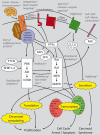PI3K-AKT-mTOR-signaling and beyond: the complex network in gastroenteropancreatic neuroendocrine neoplasms
- PMID: 24578720
- PMCID: PMC3936289
- DOI: 10.7150/thno.7851
PI3K-AKT-mTOR-signaling and beyond: the complex network in gastroenteropancreatic neuroendocrine neoplasms
Abstract
Gastroenteropancreatic neuroendocrine neoplasms are heterogeneous in their clinical behavior and require therapies specially tailored according to staging, grading, origin and expression of peptide receptors. Despite extensive scientific efforts, the therapy options are still not satisfactory. The main reasons are due to the lack of a broad mechanistic knowledge, an insufficient classification of specific diagnostic sub-groups, and predictive markers. GEP-NEN tumors evade early diagnosis because of slow asymptomatic growth behavior and are frequently not detected until metastasized. How signaling networks contribute to tumor progression and how these networks interact remains unclear in large parts. In this review we summarize the knowledge on the growth factor responsive non-angiogenetic pathways in sporadic GEP-NENs, highlight promising mechanistic research approaches, and describe important therapy targets.
Keywords: Gastroenteropancreatic neuroendocrine neoplasms; biotherapy; growth factors; inhibitor.; kinases; molecular biology; signal transduction.
Conflict of interest statement
Competing Interests: The group of Dr. Patricia Grabowski cooperates with Ipsen Pharma, Novartis and Pfizer Inc. in the context of preclinical trials and receives financial support from Ipsen Pharma and Novartis.
Figures




Similar articles
-
mTOR Pathway in Gastroenteropancreatic Neuroendocrine Tumor (GEP-NETs).Front Endocrinol (Lausanne). 2020 Nov 16;11:562505. doi: 10.3389/fendo.2020.562505. eCollection 2020. Front Endocrinol (Lausanne). 2020. PMID: 33304317 Free PMC article. Review.
-
Heat shock protein 90 is a promising target for effective growth inhibition of gastrointestinal neuroendocrine tumors.Int J Oncol. 2012 May;40(5):1659-67. doi: 10.3892/ijo.2012.1328. Epub 2012 Jan 10. Int J Oncol. 2012. PMID: 22246317
-
Prognostic and predictive role of the PI3K-AKT-mTOR pathway in neuroendocrine neoplasms.Clin Transl Oncol. 2018 May;20(5):561-569. doi: 10.1007/s12094-017-1758-3. Epub 2017 Nov 9. Clin Transl Oncol. 2018. PMID: 29124519 Review.
-
STK33 Promotes the Growth and Progression of Human Pancreatic Neuroendocrine Tumour via Activation of the PI3K/AKT/mTOR Pathway.Neuroendocrinology. 2020;110(3-4):307-320. doi: 10.1159/000501829. Epub 2019 Jul 2. Neuroendocrinology. 2020. PMID: 31261148
-
Towards a new classification of gastroenteropancreatic neuroendocrine neoplasms.Nat Rev Clin Oncol. 2016 Nov;13(11):691-705. doi: 10.1038/nrclinonc.2016.85. Epub 2016 Jun 7. Nat Rev Clin Oncol. 2016. PMID: 27273044 Review.
Cited by
-
Whole exome sequencing identifies common mutational landscape of cervix and endometrium small cell neuroendocrine carcinoma.Front Oncol. 2023 Oct 18;13:1182029. doi: 10.3389/fonc.2023.1182029. eCollection 2023. Front Oncol. 2023. PMID: 37920164 Free PMC article.
-
Somatostatin Analogue Treatment Primarily Induce miRNA Expression Changes and Up-Regulates Growth Inhibitory miR-7 and miR-148a in Neuroendocrine Cells.Genes (Basel). 2018 Jul 4;9(7):337. doi: 10.3390/genes9070337. Genes (Basel). 2018. PMID: 29973528 Free PMC article.
-
Presence of sst5TMD4, a truncated splice variant of the somatostatin receptor subtype 5, is associated to features of increased aggressiveness in pancreatic neuroendocrine tumors.Oncotarget. 2016 Feb 9;7(6):6593-608. doi: 10.18632/oncotarget.6565. Oncotarget. 2016. PMID: 26673010 Free PMC article. Clinical Trial.
-
CgB promotes EMT and stemness via MAPK pathway in colonic neuroendocrine carcinoma.Am J Cancer Res. 2023 Apr 15;13(4):1560-1570. eCollection 2023. Am J Cancer Res. 2023. PMID: 37168358 Free PMC article.
-
Berberine attenuates myocardial ischemia reperfusion injury by suppressing the activation of PI3K/AKT signaling.Exp Ther Med. 2016 Mar;11(3):978-984. doi: 10.3892/etm.2016.3018. Epub 2016 Jan 22. Exp Ther Med. 2016. PMID: 26998023 Free PMC article.
References
-
- Schimmack S, Svejda B, Lawrence B, Kidd M, Modlin IM. The diversity and commonalities of gastroenteropancreatic neuroendocrine tumors. Langenbecks Arch Surg. 2011;396:273–98. doi:10.1007/s00423-011-0739-1. - PubMed
-
- Capdevila J, Salazar R, Halperin I, Abad A, Yao JC. Innovations therapy: mammalian target of rapamycin (mTOR) inhibitors for the treatment of neuroendocrine tumors. Cancer Metastasis Rev. 2011;30(Suppl 1):27–34. doi:10.1007/s10555-011-9290-3. - PubMed
-
- Capdevila J, Tabernero J. A shining light in the darkness for the treatment of pancreatic neuroendocrine tumors. Cancer Discov. 2011;1:213–21. doi:10.1158/2159-8290.cd-11-0151. - PubMed
-
- Hilfenhaus G, Gohrig A, Pape UF, Neumann T, Jann H, Zdunek D. et al. Placental growth factor supports neuroendocrine tumor growth and predicts disease prognosis in patients. Endocr Relat Cancer. 2013;20:305–19. doi:10.1530/erc-12-0223. - PubMed
-
- Oberstein PE, Saif MW. Update on prognostic and predictive biomarkers for pancreatic neuroendocrine tumors. JOP. 2012;13:368–71. doi:10.6092/1590-8577/965. - PubMed
Publication types
MeSH terms
Substances
LinkOut - more resources
Full Text Sources
Other Literature Sources
Medical
Miscellaneous

